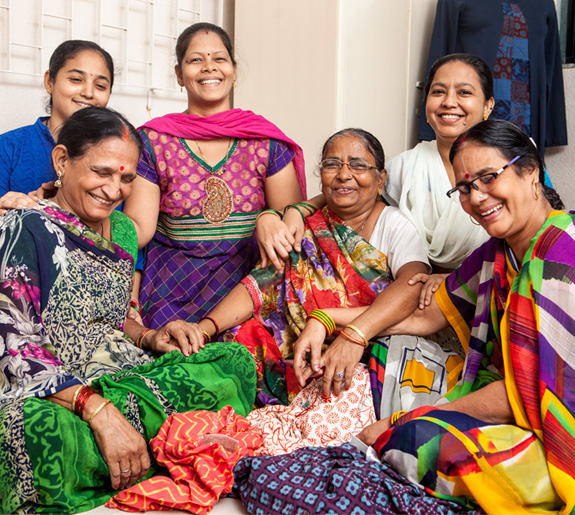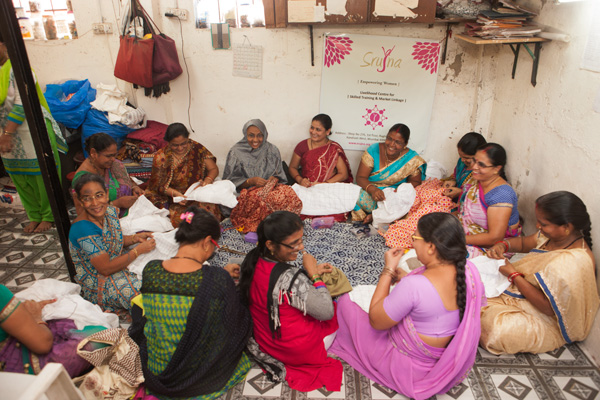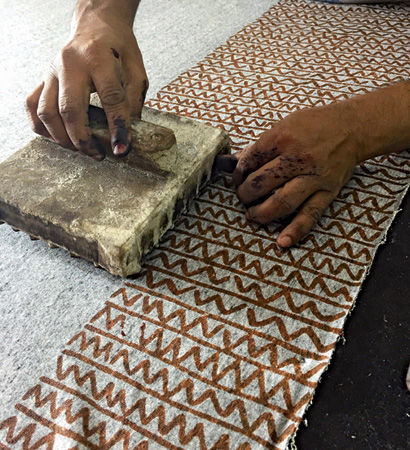How Constraints Built Our Brand
October 11, 2019 | By Pushpika Freitas, President of MarketPlace
When I started MarketPlace, I viewed myself as a social worker and simply wanted to provide women with an opportunity to earn a living. That original goal has evolved into empowering women and bringing about social change. From the very beginning MarketPlace was shaped by constraints.

Constraint #1: Women needed flexible hours without a long training period.
The criteria that determined which women could participate, and the restrictions of their lives shaped the direction the program took. There were two requirements for the women: need, and a commitment to working to earn a living. Skill was not necessary, because these women did not have the exotic embroidery skills seen in some parts of India. At best they had basic sewing skills learned to repair clothing. The most significant constraints were that these women needed to earn immediately not spend months in training, and they needed to be able to work from home.
Working within these requirements, we had to find something that did not need machines which would take up space in their already small homes and that they could learn and earn quickly. Hand embroidery fit this bill. We chose stitches that were not complicated to do but added an aesthetic that was distinctive and beautiful. We sometimes used the print of the fabric as a template for the hand embroidery, which avoided having to use a stencil. That would have added an additional step and problems in quality. We combined stitches in different says to provide variety in appearance.
70% of the women do hand embroidery at home and this gives them the flexibility to manage their time and responsibilities. Every MarketPlace product has some hand embroidery. It is a creative challenge to develop hand embroidery patterns which enhance the fabric and style of the garment rather than distract the eye. This is why we have the embroidery workshop for each line where the women experiment with colors of the thread, stitches and placement. This process empowers the women and raises their creativity.

Constraint #2: Ownership is power, but starting a new cooperative and running it is difficult.
As MarketPlace grew from its very small beginning, we came to believe that true empowerment meant that the women had to be involved in all aspects or the business. In fact, they should own their businesses. Instead of a top down model, this meant that the artisans had to set up their own small cooperatives or collectives. In these small independent businesses, they make decisions regarding timing, payment structures and take responsibility for managing production, quality, packing, finances, etc. The cooperatives have been a proving ground which has led to many women taking on leadership roles. Being organized in this way the groups have encouraged the building of bonds as the women support each other in all aspects of their lives. All of them see the group as their family.
The groups are small and range from 12 to 40 members, and are located in different locations in and outside of Mumbai. Communication, training and production planning are all big challenges. In addition, not all groups are at the same experience and skill level. As we expand the network, new groups are formed. The learning never stops, as each Spring and Fall we have a completely new line with new fabrics, silhouettes and embroidery. The women have to be trained for each line, they have to make production samples that have to be passed and the fabric when it comes in has to be checked for color. It is no wonder that factories are set up where production is done under one large roof. But that model does not fit with our mission.
The different groups are at different skill levels and when designing the line, thought is given to having a balance of products that are simple to sew and products that are more complicated. Everything is rated by skill level and the cooperatives are encouraged and trained to move up in their skill.

Constraint #3: Hand printed fabric means more employment but has tremendous challenges.
We use hand printed or hand-woven fabric because the work generated through that is tremendous. In addition, we value helping to preserve the age-old techniques of Hand Block Printing, Batik, Kalamkari, Ikat and Ajrak. Modern mill-made fabric, sometimes imitating the hand prints, are much easier to produce and require less labor. In our case we want to increase employment, with the added bonus of better quality.
With hand printing and dyeing, small dye lots are used and it is a challenge to keep the color consistent. We work with small fabric producers, oftentimes family-run businesses and even getting the raw fabric can be difficult because they buy in smaller quantities. Another variable that must be taken into account is the weather. In the monsoons, the rain and humidity make drying difficult. Very dry conditions affects how the dye reacts with the air. Sometimes the sample fabric is made during the summer's hotter dry months and the production fabric has to be made during the cooler months. A lot of adjustments have to be at the time of production to get the right color.
However, on the bright side, innovation and experimentation are easier because of the small scale and flexibility. We have combined techniques for a unique look, such as using Ikat hand woven fabric with block prints. With hand painting, we have experimented with different sizes of brushes, done splatter prints with a stick broom and used bristle brushes, all of which give different effects.
Because the fabrics are so time consuming, we are constantly refining our inventory management systems to get the garments you want when you order. Printing fabric and making garments that sit in the warehouse for a long time is a waste of resources. We work hard to get the colors right. Fabric is rejected if the color is incorrect and sometimes it can be processed to get the right color. When that is not possible, the fabric is 'reinvented' either over printed or over dyed to make a new product for the next season. Zero waste!

Constraint #4: Up-Cycling helps the environment but the logistics of converting Chindis into marketable products is tremendous.
The garment industry is famous for filling up landfills. Waste fabric from cutting (Chindis) is one of the problems. Using the chindis has helped us fulfill two important aspects of our mission, training and environmental conservation. The chindis are cut in various shapes and joined together by trainees giving them a chance to learn how the machine works and gain experience.
Creativity plays an important in making this happen. Scraps from cutting are not always in the same sizes or colors and over a season, it is difficult to determine how much will be generated from one color. To solve this, we have started over dyeing the patchwork chindis, or hand painting or block printing on them. These techniques give them a more coordinated look. In addition, the very small chindis that cannot be worked into patchwork are used to make fabric balls and tassels for scarves and bags. Adding patchwork strips, yokes, cuffs, and pockets adds detail, interest and texture, thus transforming a challenge into an opportunity.
